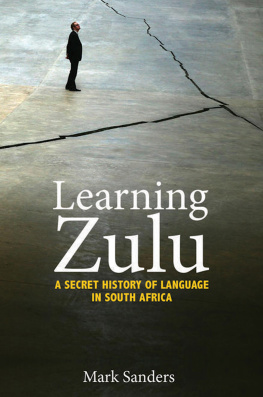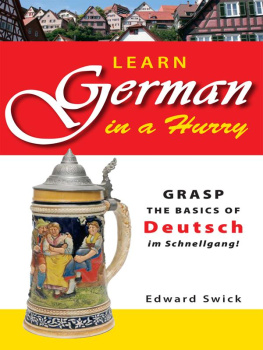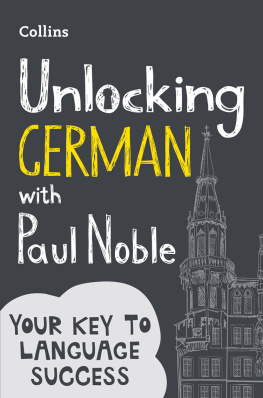German

GERMAN
Biography of a Language
RUTH H. SANDERS


Oxford University Press, Inc., publishes works that further
Oxford Universitys objective of excellence
in research, scholarship, and education.
Oxford New York
Auckland Cape Town Dar es Salaam Hong Kong Karachi
Kuala Lumpur Madrid Melbourne Mexico City Nairobi
New Delhi Shanghai Taipei Toronto
With offices in
Argentina Austria Brazil Chile Czech Republic France Greece
Guatemala Hungary Italy Japan Poland Portugal Singapore
South Korea Switzerland Thailand Turkey Ukraine Vietnam
Copyright 2010 by Oxford University Press, Inc.
Published by Oxford University Press, Inc.
198 Madison Avenue, New York, NY 10016
www.oup.com
Oxford is a registered trademark of Oxford University Press
All rights reserved. No part of this publication may be reproduced,
stored in a retrieval system, or transmitted, in any form or by any means,
electronic, mechanical, photocopying, recording, or otherwise,
without the prior permission of Oxford University Press.
Library of Congress Cataloging-in-Publication Data
Sanders, Ruth H.
German : biography of a language / Ruth H. Sanders.
p. cm.
Includes bibliographical references and index.
ISBN 978-0-19-538845-9
1. German languageHistory.
2. German languageSocial aspects.
3. SociolinguisticsGermany. I. Title.
PF3075.S26 2010
430.9dc22
2009038656
Frontispiece: Thusnelda im Triumphzug des Germanicus Thusnelda in the triumphal procession of Germanicus, painting by Carl Theodor von Piloty, 1873. Thusnelda, wife of the Germanic leader Arminius, with their young son Thumelicus and her retinue, paraded in Rome as captives of the Roman general Germanicus on May 26 of the year 17 AD. Photo: Blauel/GnammArtothek. Neue Pinakothek, Munich, Germany. By permission of Artothek.
1 3 5 7 9 8 6 4 2
Printed in the United States of America
on acid-free paper
Preface
THE German language has a long history, beginning perhaps as early as six thousand years ago. Linguists, that is, scientists of language, have been tracing its roots since the late eighteenth and nineteenth centuries, working with at times nothing more than scraps of ancient Germanic languages, often written in foreign alphabets or runes. These scientists provided the first piece of the puzzle: the stages of development of the language; pronunciation changes, grammar changes, and vocabulary additions, and how they came to be. Modern linguists have continued their work, and in fantastic detail they have reconstructed early German in its many historical stages going back thousands of years.
Recently other sciencesanthropology, archaeology, geneticshave developed exacting methods to turn their microscopes, in closer focus than ever before, on prehistoric peoples and languages. Their results enable us to see a second piece of the puzzle, that is, when and where Neolithic (Late Stone Age) peoples settled, when they began using agriculture and animal husbandry, what cultural contacts they made, and hence what languages could have influenced other languages (including Germanic). Their work has dated some linguistic events earlier than had previously been estimated, in some cases by more than a thousand years.
In the last centuries of the pre-Christian era, Greek and Roman historians and military men (for example, Julius Caesar) described their encounters with the Germanic peoples. What they wrote not only defined how the Greeks and Romans viewed these peoples, whom they called barbarians, but also colored our own view, since until recently we had few other sources. The pre-medieval speakers of Germanic languages did not (with the exception of the Goths) have writing, so their side of the story is largely lost to history. However, anthropologists, archaeologists, and geneticists have discovered ways to reanimate the Germanic peoples of Roman times and even earlier, through their bones, their craft work, their graveyards, their trash piles, and their genetic material. These findings have begun to provide the human picture, which can tell us which peoples intermarried with which other peoples, when the Germanic peoples took up the foods and clothing styles of the Romans, and which ones gave up their native language and which ones didnt.
In tribal times the Germanic languages were divided; by medieval times they began to coalesce into what would become German and what would become its sister languages: English, Netherlandic (Dutch and Flemish), Afrikaans, Frisian, Yiddish, Danish, Norwegian, Swedish, Icelandic, and Faroese. But by then the written record could yield the story of German, sometimes even through the lives of individuals. Here the findings of historians who have performed their reanimation tasks in archives and libraries take over the narrative.
This story, then, is one told by many scholars of many disciplines. Bringing all the parts of the story into one narrative, as this book attempts to do, involves the risk that the author will misinterpret the findings of fields other than her own. It seems to me, however, that the German language is due for a wide-ranging historical assessment, using the knowledge not only of linguistics but also of other sciences, and I can only hope I have been equal to the task.
Many colleagues and friends have graciously read and commented on the manuscript, or parts of it, as it developed. For their insight and encouragement, I express here my thanks to Renee Miller, Audrone Willeke, Gerda Bikales, Winfried Thielmann, Gene Willeke, K.E. Smith, Michael Bachem, Jacqueline Vansant, Mila Ganeva, Mathias Schulze, Robert DiDonato, Karen OHara, Pirkko Suihkonen, and Stephen Nimis. Thanks too to Dan Meyers, who provided technical assistance. To Kevin Kirby, special thanks are due for getting me off to a good start by giving me his copy of Orrin Robinsons Old English and Its Closest Relatives (1992). To the anonymous reviewers of Oxford University Press, my gratitude for their generous comments as well as their exacting standards. To my editors at Oxford University Press, special thanks: to Brian Hurley, for his good judgment and encouragement at all the right moments; to Joellyn Ausanka, for her skillful editing and hard work. Of course, whatever errors remain in the book are mine alone.
One additional note: I have quoted in English from many works in German; unless otherwise noted, all translations are my own.
Miami University in Oxford, Ohio, gave me essential support in the form of a year-long leave that enabled me to do much of my research in Munich, Germany; and the Institut Deutsch als Fremdsprache of the Ludwig-Maximilians-Universitt in Munich provided me with a professional home during my year in Munich. Miami Universitys King Library, particularly its Special Collections and Digital Initiatives departments, was extremely helpful in locating materials. My thanks to these institutions and the people who make them work.
Finally, to my husband, Alton Sanders, my deepest gratitude not only for his reading of and comments on the manuscript, but even more for his steady support and encouragement. It is to him that this book is dedicated.
Contents
Introduction
Next page













